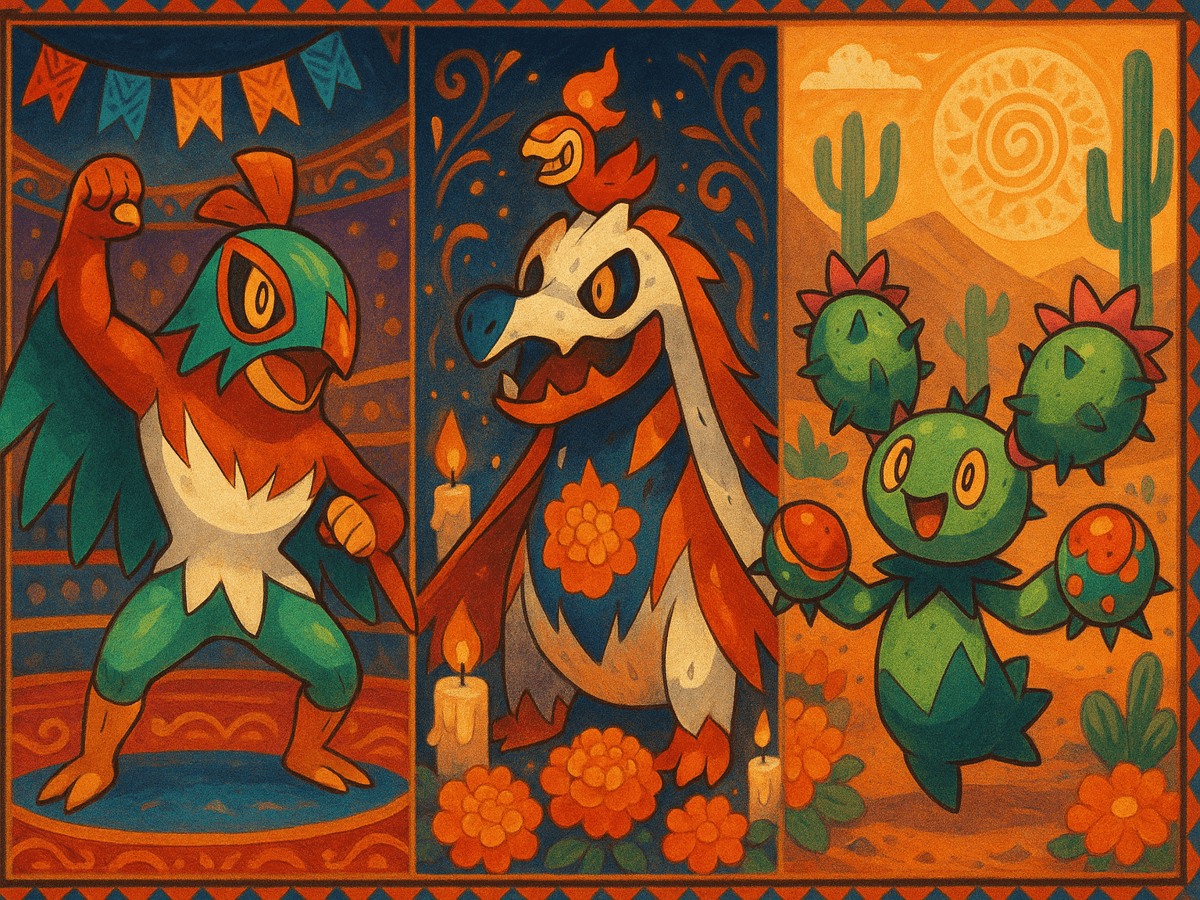From the Ring to the Day of the Dead: Pokémon Inspired by Mexico

Few regions in the world can boast such cultural richness as Mexico. Land of ancient civilizations, living beliefs, and vibrant traditions, this country has always inspired artists, filmmakers, authors — and even video game designers. The Pokémon universe, known for drawing from myths and cultures around the world, is no exception.
Since its inception, the franchise has created creatures inspired by universal symbols, but also by very specific cultural motifs. And over the generations, some Pokémon have clearly drawn from the Mexican imagination: colorful luchador masks, festive spirits of the Día de los Muertos, dancing cacti...
Hawlucha, Pokémon Incarnation of Lucha Libre
Hawlucha (Brutalibré) is a visual and behavioral condensation of Lucha Libre, a cultural phenomenon deeply rooted in Mexico since the early 20th century. Lucha Libre is a dramatic and symbolic art. Each fighter embodies a role: the masked hero, the provocative villain, the trickster... And these are the archetypes that Hawlucha brilliantly takes on.
Its Fighting / Flying type reinforces this duality: the wrestling holds and aerial attacks recall the spectacular acrobatics of the luchadores. Its mask is not just a simple accessory: in Mexican culture, a luchador's mask is sacred, often passed down from generation to generation. Losing it during a special match (Lucha de Apuestas) is considered humiliating.
Hawlucha incorporates all of this into its DNA. Even in the Pokémon anime, it is often portrayed as noble and theatrical. A subtle nod to this tradition where the arena becomes a theater of honor.
Skeledirge, Sacred Fire and Spirit of the Ancestors
Skeledirge is the result of a masterful work around Mexican symbolism. Its bony appearance, combined with singing flames and a small spectral creature accompanying it, evokes the celebrations of the Día de los Muertos, a festival deeply rooted in pre-Hispanic cultures.
The Día de los Muertos is a time of reunion between the living and the dead. Families decorate altars with photos, offerings, and flowers — especially cempasúchil, those orange marigolds, a color found in Skeledirge’s palette. Its song that revives the flame of life is a beautiful metaphor of memory that keeps the departed alive in hearts.
The Pokémon also evokes alebrijes, those imaginary sculptures created by artist Pedro Linares, populated with colorful patterns and fantastic animals. Skeledirge is a synthesis of these: part-musician, part-spirit, flamboyant and protective.
Maractus, Joyous Cactus to the Rhythm of Mariachis
Maractus might seem light at first glance, but its design is more thought-out than it appears. Music is omnipresent in Mexican celebrations, and the mariachi style is its most universally known expression. Born in Jalisco, this musical genre is distinguished by its violins, trumpets, and guitars, but especially by its inseparable link with celebrations.
Maractus merges the maracas, emblematic percussion instruments of Latin American popular music, with a cactus, a plant inseparable from Mexico's arid landscapes. In the games, this Pokémon uses moves like Petal Dance or Healing Vibrations, affirming its connection to music and healing, symbols of life.
It is a Pokémon of joy, of celebration, but also of resilience — for like cacti, it is capable of surviving in the most hostile environments.
A Folklore to Tame, a Breeding Ground for Future Creatures
These three Pokémon demonstrate the richness of the link between local culture and video game imagination. Mexico is still full of symbols that Pokémon could explore. A creature inspired by Quetzalcoatl, the feathered serpent god? A Pokémon based on the Xoloitzcuintles, sacred dogs believed to guide souls in the afterlife? Or even an entity modeled after Aztec jaguar warriors?
The Mexican bestiary, between deities, totem animals, and ritual objects, could easily feed a future Pokémon region entirely dedicated to Central America. A fictional region mixing ancient civilizations and contemporary folklore would be a marvelous playground, between pyramids, colorful markets, and ancestral spirits.
In the background, these Pokémon show how video games are also a cultural mirror. For the younger ones, they are fun, powerful, or cute. For adults, they can be gateways to other worlds: that of Lucha Libre, Mesoamerican cosmogony, or popular art. And for those who want to extend the adventure, there are coloring pages! A fun way to revisit Mexican traditions... with a colored pencil in hand.
